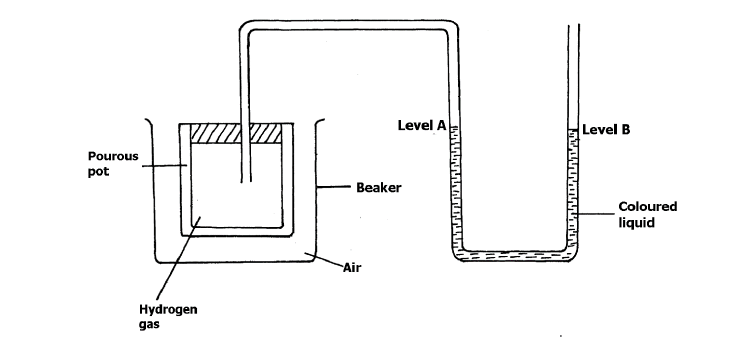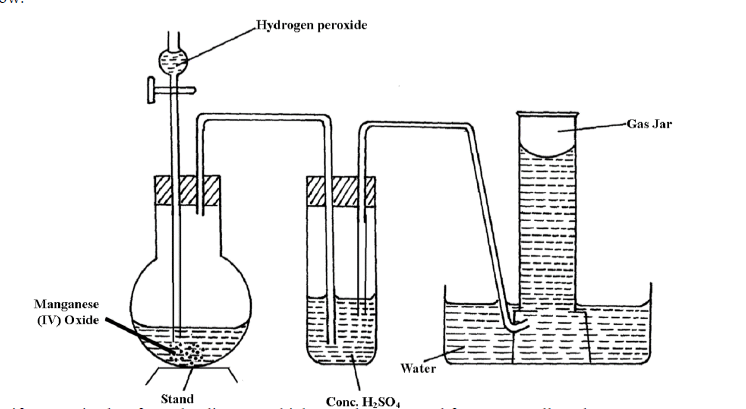-
Study the set-up of apparatus below and answer the questions that follow.
(Solved)
Study the set-up of apparatus below and answer the questions that follow.

a) State and explain the observation that would be made in tube L as the experiment progresses in the first few minutes.
Observation.
Explanation.
b) How would the observations in the tube L change if the experiment is carried out for a long time. Explain using a chemical equation.
Observation.
Equation.
c) State three observations made when liquid S is reacted with sodium metal.
d) State the use of the suction pump in this experiment.
Date posted:
September 19, 2019
.
Answers (1)
-
When solid Zinc carbonate was added to a solution of hydrogen chloride in methylbenzene, there was no observable change.On addition of some water to the...
(Solved)
When solid Zinc carbonate was added to a solution of hydrogen chloride in methylbenzene, there was no observable change.On addition of some water to the mixture there was effervescence. Explain these observations.
Date posted:
September 19, 2019
.
Answers (1)
-
The diagram below shows the heating curve of a pure substance. Study it and answer the questions that follow.
(Solved)
The diagram below shows the heating curve of a pure substance. Study it and answer the questions that follow.

(a) What are the physical states of the substances at points W and Y.
(b) Explain why the temperature remains constant between points B and C.
Date posted:
September 19, 2019
.
Answers (1)
-
Potassium manganate (VII) reacts with chloride salts to produce chlorine. Both chlorine and potassium manganate (VII) are strong oxidizing agents. Which one of the two...
(Solved)
Potassium manganate (VII) reacts with chloride salts to produce chlorine. Both chlorine and potassium manganate (VII) are strong oxidizing agents. Which one of the two is the stronger oxidizing agent? Explain your answer
Date posted:
September 19, 2019
.
Answers (1)
-
When a grey powder P, which has no action on cold water is placed into a salt solution of Q, a brown solid R is...
(Solved)
When a grey powder P, which has no action on cold water is placed into a salt solution of Q, a brown solid R is deposited.
The blue solution of Q, fades giving way to a green solution.
a) Name the type of reaction that takes place.
b) Identify solids P and R
c) Write an equation for the reaction leading to formation of the brown solid.
Date posted:
September 19, 2019
.
Answers (1)
-
Methane gas reacts with chlorine gas as shown in the equation below.
(Solved)
Methane gas reacts with chlorine gas as shown in the equation below.

Use the bond energies in the table below to calculate the enthalpy for the above reaction.

Date posted:
September 19, 2019
.
Answers (1)
-
The set- up below was used to investigate the rate of diffusion of different gases.
(Solved)
The set- up below was used to investigate the rate of diffusion of different gases.

a) Explain why a coloured liquid is used in this experiment.
b) State and explain the observation made after 20 minutes.
Date posted:
September 19, 2019
.
Answers (1)
-
The table below gives information about some reactions of metals A,B, C and D and their rates.
(Solved)
The table below gives information about some reactions of metals A,B, C and D and their rates.

Arrange the metals in order of decreasing activity.
Date posted:
September 19, 2019
.
Answers (1)
-
The diagram below shows the set-up that can be used to prepare and collect oxygen gas. Study it and answer the questions that follow.
(Solved)
The diagram below shows the set-up that can be used to prepare and collect oxygen gas. Study it and answer the questions that follow.

Identify two mistakes from the diagram which must be corrected for one to collect dry oxygen gas.
Date posted:
September 19, 2019
.
Answers (1)
-
State the conditions under which ammonia gives the following products when heated
(i) Nitrogen and hydrogen.
(ii) Nitrogen and water.
(iii) Nitrogen (II) oxide and water.
(Solved)
State the conditions under which ammonia gives the following products when heated
(i) Nitrogen and hydrogen.
(ii) Nitrogen and water.
(iii) Nitrogen (II) oxide and water.
Date posted:
September 19, 2019
.
Answers (1)
-
The following diagram was used to study a property of hydrogen gas. Study it and answer the questions that follow.
(Solved)
The following diagram was used to study a property of hydrogen gas. Study it and answer the questions that follow.

a) Name the missing condition in the above set up.
b) Explain why the combustion tube is clamped in a slanting position.
c) Before lighting the gas at the end of delivery tube, hydrogen must be let to pass through until all the air is driven out. Explain.
d) State three observations that occur in the combustion tube.
e) Why was hydrogen gas burnt at point Z.
f) Why should the supply of hydrogen gas be continued while the apparatus cool.
g) What would be observed if the experiment was repeated using lead (II) oxide.
h) Other than the property investigated above, name two other chemical properties of hydrogen gas.
Date posted:
September 19, 2019
.
Answers (1)
-
Calculate the mass of sodium carbonate contained in 200cm3 of 0.02M sodium carbonate solution.
(Solved)
Calculate the mass of sodium carbonate contained in 200cm3 of 0.02M sodium carbonate solution.
Date posted:
September 19, 2019
.
Answers (1)
-
A sample of 10cm3 of hydrogen sulphide was burned in 40cm3 of oxygen. Calculate the volume and composition of residual gas (assume all volumes are...
(Solved)
A sample of 10cm3 of hydrogen sulphide was burned in 40cm3 of oxygen. Calculate the volume and composition of residual gas (assume all volumes are measured at s.t.p)
Date posted:
September 19, 2019
.
Answers (1)
-
The diagram below represents a set up that was used for electrolysis of aqueous copper (II) nitrate.
(Solved)
The diagram below represents a set up that was used for electrolysis of aqueous copper (II) nitrate.

A gas that relights a glowing splint was produced at electrode A.
i) Which electrode is the cathode ? Explain.
ii) State another suitable method for collecting gas X.
iii) Write ionic equations to show reactions that take place at the :
Anode
Cathode
iv) Explain how the identity of the product at the cathode of this electrolysis can be confirmed.
v) Calculate the mass of copper deposited if a constant current of 5 A was passed for 3 hours. (Cu = 63.5, IF = 965000)
Date posted:
September 18, 2019
.
Answers (1)
-
Excess concentrated sulphuric VI acid was mixed with pieces of dry wood as shown.
(Solved)
Excess concentrated sulphuric VI acid was mixed with pieces of dry wood as shown.

a) State the observation made in the tube.
b) When the reaction was complete, the mixture was heated gently, then strongly and set up adjusted as shown below.

State and explain the observation made on acidified potassium chromate VI solution.
Date posted:
September 18, 2019
.
Answers (1)
-
The table below shows properties of some chlorides. Study it and answer the questions that follow.
(Solved)
The table below shows properties of some chlorides. Study it and answer the questions that follow.

a) Explain the high melting and boiling points of sodium chloride.
b) Write an equation for the reaction between PC15 and water.
c) Draw the dot (•) and cross (x) diagram to show bonding in NaCl.
Date posted:
September 18, 2019
.
Answers (1)
-
The labels of two reagent bottles contained the following safety symbols.
(Solved)
The labels of two reagent bottles contained the following safety symbols.

a) What do the symbols mean ? Explain.
b) Which of the reagent is more harmful ?
Date posted:
September 18, 2019
.
Answers (1)
-
What volume of oxygen gas at r.t.p will be liberated at the anode when a current of 3 amperes is passed through magnesium sulphate solution...
(Solved)
What volume of oxygen gas at r.t.p will be liberated at the anode when a current of 3 amperes is passed through magnesium sulphate solution for 45 minutes and 30 seconds. (Molar gas volume at r.t.p = 24000cm3, Faraday constant = 96500
Coulombs)
Date posted:
September 18, 2019
.
Answers (1)
-
When bismuth III Chloride is added to water, a reaction occurs and a white precipitate forms as shown below.
BiCI3(aq) + H20(l) BiOCl(s) + 2HCl(aq)
What would...
(Solved)
When bismuth III Chloride is added to water, a reaction occurs and a white precipitate forms as shown below.
BiCI3(aq) + H20(l) BiOCl(s) + 2HCl(aq)
What would be the effect on the amount of the precipitate formed if sodium hydroxide solution is added to the equilibrium mixture ? Explain your answer.
Date posted:
September 18, 2019
.
Answers (1)
-
Explain why iron nails rust faster in sodium chloride solution than in tap water.
(Solved)
Explain why iron nails rust faster in sodium chloride solution than in tap water.
Date posted:
September 18, 2019
.
Answers (1)